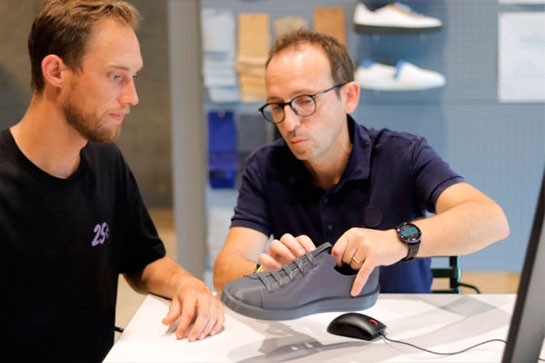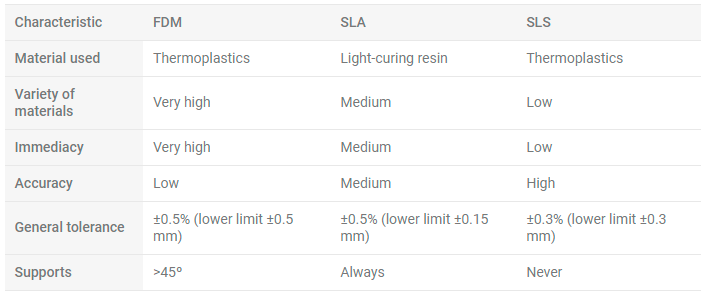
A prototype is the first example of a product to be manufactured, serving as a starting point for carrying out the necessary modifications, as a model to replicate or as a matrix to produce a mould.
Thus, prototyping is an experimental process through which design teams can materialise their ideas. Prototyping is a very useful process in various sectors, allowing iterations to be carried out until the desired result is achieved.

Image 1: 3D printed helmet prototype with Raise Pro2 Plus. Source: KIDO Sports.
There are several types of product prototyping with different functions:
- Low fidelity prototypes: Low-fidelity prototypes can be carried out in a short period of time, with great immediacy, and act as a study model, allowing different aspects to be analysed in order to make the necessary modifications to the model before reaching the final product design.
- Design prototypes: Design prototypes are carried out in order to validate the product design.
- Geometric prototypes: This type of prototype is produced to check the geometry of the product and modify it if necessary.
- Functional prototypes: These prototypes are carried out to analyse the behaviour of the materials used and to test the functionality of the product.
- Technical prototypes: In this case, the prototype is used as a global study model, allowing all its features to be analysed.
- High fidelity prototypes: They consist of the manufacture of a prototype identical to the final product. It is highly recommended to carry out this type of prototyping before carrying out the mass production of a product.
Currently there are several processes for the manufacture of prototypes, such as CNC machining, injection moulding, or 3D printing.
Rapid prototyping
3D printing is directly related to rapid prototyping because of the immediacy offered by this manufacturing method and the various possibilities it offers depending on the technology used and the materials used, making it a widely used manufacturing method for low-fidelity prototyping.
Video 1: Rapid prototyping of DLimit. Source: BCN3D.
Rapid prototyping using 3D printing aims to manufacture models to test one or more aspects of the product and thus be able to modify it if necessary in an agile and immediate way until the final design is achieved, ensuring both the form and functionality of the product.
For the manufacture of prototypes using 3D printing, it must be taken into account which technology is the most suitable. Each technology has advantages and disadvantages, so it is necessary to know the fundamentals on which its operation is based as well as its limitations in order to find the most suitable for each need.
The most widespread 3D printing technologies are:
- Fused material deposition (FDM)
- Selective light curing of resins (SLA)
- Selective laser sintering (SLS)
A comparison table between them can be seen below:
| Characteristic | FDM | SLA | SLS |
|---|---|---|---|
| Material used | Thermoplastics | Light-curing resin | Thermoplastics |
| Variety of materials | Very high | Medium | Low |
| Immediacy | Very high | Medium | Low |
| Accuracy | Low | Medium | High |
| General tolerance | ±0.5% (lower limit ±0.5 mm) | ±0.5% (lower limit ±0.15 mm) | ±0.3% (lower limit ±0.3 mm) |
| Supports | >45º | Always | Never |

Table 1: Comparison between different 3D printing technologies. Source: Filament2print.
For a more in-depth look at the characteristics and limitations of each technology, we recommend reading the article "How to choose the right technology: FDM, SLA and SLS".
Some of the advantages offered by 3D printing prototyping are:
Speed: Depending on the 3D printing technology used, the production speed will be higher or lower, but 3D printing is, in general, a manufacturing method that offers immediacy.
Cost and resource savings: Depending on the complexity of the part and the materials used, the use of 3D printing for prototyping parts can lead to significant cost and resource savings compared to other traditional manufacturing methods.
Sustainability: By having 3D printing equipment in the company's own production facilities, prototypes are produced locally, which reduces the carbon footprint produced compared to external manufacturing. In addition, it is often possible to work with biodegradable, recycled or recyclable materials and, by the very nature of the manufacturing method, waste and material wastage is minimised.
From prototyping to manufacturing
Initially, 3D printing was only used for prototyping. However, it is now also used as an additional manufacturing method. This is mainly due to two factors:
Development of materials
One of the factors that make it possible to manufacture small runs of final parts with 3D printing is the development of materials that enable applications for demanding environments thanks to their mechanical properties or specific properties.
An example of this is ESD materials, which are available in filament, powder and even resin form, and which enable products to be manufactured with electrostatic discharge protection.
Advances in 3D printing technologies
Thanks to the advances made in recent years and the R&D work of equipment manufacturers, the features offered by 3D printers have improved significantly, to the point of being able to manufacture highly complex parts with industrial quality.
All 3D printing technologies have advanced considerably. Examples are FormLabs' SLA 3D printers for the medical and dental sector, Form 3B+ and Form 3BL, which can 3D print biocompatible materials; or Sinterit's SLS 3D printers, which can produce highly complex parts without the need for supports, as well as desktop models such as Lisa, Lisa Pro or Lisa X.

Image 3: Manufacture of final products for the dental sector. Source: FormLabs.
Without a doubt, 3D printing manufacturing allows professional users to produce prototypes and even final parts of industrial quality, and is currently one of the most widely used manufacturing methods for rapid prototyping in a multitude of sectors. Thanks to the variety of technologies, equipment and materials, it is possible to find solutions for almost any application.












